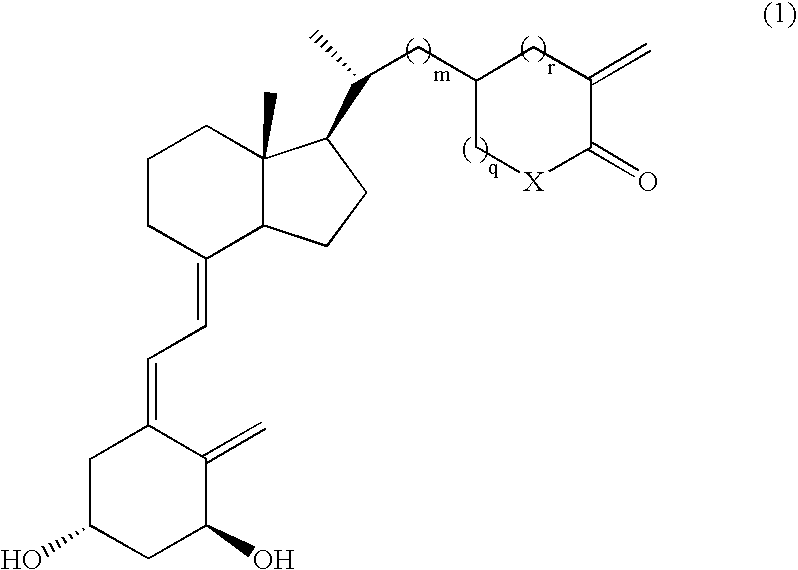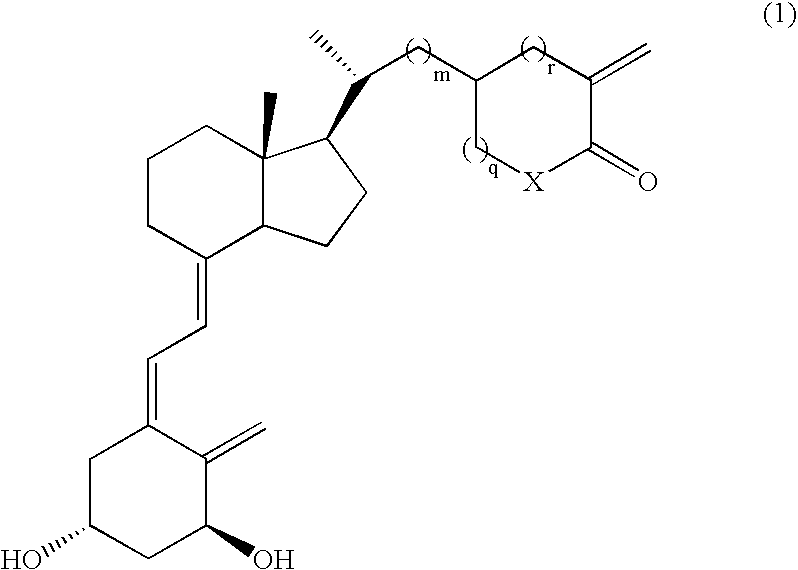Parathyroid hormone production inhibitors containing vitamin d3 derivatives
a technology of vitamin d3 and production inhibitors, applied in the field of parathyroid hormone, can solve the problems of insufficient separation, difficult to suppress the proliferation of parathyroid cells, and decreased receptors of parathyroid glands, and achieve the effect of increasing the calcium concentration in the serum
- Summary
- Abstract
- Description
- Claims
- Application Information
AI Technical Summary
Benefits of technology
Problems solved by technology
Method used
Image
Examples
example 1
Action of (23S)-25-dehydro-1α,25-dihydroxyvitamin D3-26,23-lactone (Compound No.11 (23S Isomer) on the Production of PTH in Vitamin D Deficient Rat with Time
[0028] (1) Male Wistar rats of 4 weeks old were purchased from Japan SLC (SLC, Shizuoka prefecture). The rats were put into wire cages three for each cage and bred under the condition of 23±1° C. and 55±10% humidity by allowing the rats to free ingestion of a vitamin D deficient feed for animal breeding (Ca, 0.0036%; P, 0.3%; Harlan Teklad Research Diet, Madison, Wis., U.S.A.) and drinking water (well water treated with 0.4%±0.2 ppm hypochlorite) for 7 weeks. The number of animals were five for one group.
[0029] (2) As shown in the Table 2, the negative control group (Group 1) was administered with a solvent (5% ethanol / 0.1% Triton X-100 / physiological saline solution) and the positive control group (Group 2) was administered with 0.5 μg / kg of 1α,25-dihydroxyvitamin D3 by intravenous administration.
[0030] (3) As the group admi...
example 2
Change of Serum PTH Concentration and Serum Calcium Concentration of Vitamin D Deficient Rat 8 Hours After the Administration of (23S)-25-dehydro-1α-dihydroxyvitamin D3-26,23-lactone (Compound No.11 (23S Isomer) at Various Concentrations
[0037] (1) The experimental animals, the breeding conditions, etc., of the experiment were similar to those of the Example 1.
[0038] (2) As shown in the Table 3, the negative control group (Group 1) was administered with a solvent (5% ethanol / 0.1% Triton X-100 / physiological saline solution) and the positive control group (Group 2) was administered with 0.25 μg / kg of 1α,25-dihydroxyvitamin D3 by intravenous administration.
[0039] (3) As the group administered with the vitamin D3 derivative, the group (Group 3) was administered with the compound 11 (23S isomer) at a dose of 2 μg / kg, 10 μg / kg and 50 μg / kg by intravenous administration. The volume of administered solution was 2 mL / kg.
[0040] (4) The blood was collected from the descending abdominal aor...
example 3
Calcium Metabolic Activity of Vitamin D Deficient Rats 8 Hours after the Administration of (23S)-25-dehydro-1α,25-dihydroxyvitamin D3-26,23-lactone (Compound No.11 (23S isomer)) at Various Concentrations
[0043] (1) The experimental animals, the breeding conditions, etc., of the experiment were similar to those of the Example 1.
[0044] (2) As shown in the Table 4, the negative control group (Group 1) was administered with a solvent (5% ethanol / 0.1% Triton X-100 / physiological saline solution) and the positive control group (Group 2) was administered with 1α,25-dihydroxyvitamin D3 at a dose of 0.1 μg / kg, 0.5 μg / kg and 2.5 μg / kg by intravenous administration.
[0045] (3) As the group administered with the vitamin D3 derivative, the group (Group 3) was administered with the compound 11 (23S isomer) (Group 3) at a rate of 10 μg / kg, 50 μg / kg and 250 μg / kg by intravenous administration. The volume of administered solution was 2 mL / kg.
[0046] (4) The blood was collected from the descending a...
PUM
 Login to View More
Login to View More Abstract
Description
Claims
Application Information
 Login to View More
Login to View More - R&D
- Intellectual Property
- Life Sciences
- Materials
- Tech Scout
- Unparalleled Data Quality
- Higher Quality Content
- 60% Fewer Hallucinations
Browse by: Latest US Patents, China's latest patents, Technical Efficacy Thesaurus, Application Domain, Technology Topic, Popular Technical Reports.
© 2025 PatSnap. All rights reserved.Legal|Privacy policy|Modern Slavery Act Transparency Statement|Sitemap|About US| Contact US: help@patsnap.com



